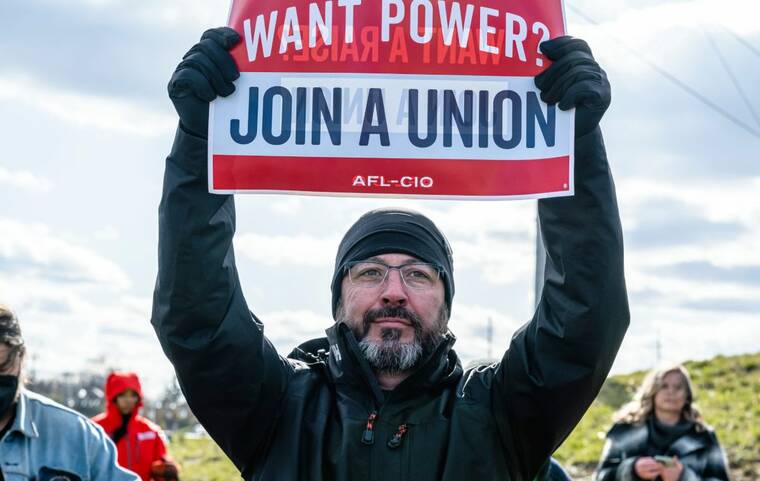Powerful labor group joins AFL-CIO ahead of new Trump era

JON CHERRY/THE NEW YORK TIMES
An Amazon Labor Union supporter holds an AFL-CIO sign during a rally near the Amazon Air Hub in Hebron, Ky., in March 2023. Two prominent labor groups are joining forces in an attempt to expand union membership and protect members’ interests as they face the likelihood of a less union-friendly federal government under Donald Trump.
Two prominent labor groups are joining forces in an attempt to expand union membership and protect members’ interests as they face the likelihood of a less union-friendly federal government under Donald Trump.
The Service Employees International Union, which represents nearly 2 million workers in industries like home health care and janitorial services, said Wednesday that it would become part of the AFL-CIO, an umbrella group of more than 50 unions that represents more than 12.5 million workers.
The boards of the two groups formally approved the affiliation arrangement earlier in the day.
April Verrett, the service employees’ president, said in an interview that the union had begun discussing the possibility of joining the AFL-CIO almost two years ago, and that discussions with the federation and its president, Liz Shuler, accelerated early last year.
In a statement, the two groups said the partnership would help them push for changes to local, state and federal rules that made it easier for workers to join unions, and help them support “multiunion, multisector” campaigns to organize workers.
The move suggests how forces largely aligned with the Democratic Party might try to reposition themselves to deal with the coming administration and a Republican-controlled Congress.
Don't miss out on what's happening!
Stay in touch with breaking news, as it happens, conveniently in your email inbox. It's FREE!
Verrett and Shuler said the alliance was unrelated to the result of November’s presidential election, but they acknowledged that it would help organized labor fend off potential threats from the Trump administration.
They cited an expansive list of concerns, including the possibility of mass deportation of workers living in the country without legal permission; cuts to Medicaid; attacks on protections for federal employees; a rollback of investments in green energy; and a commission empowered by Trump to slash government spending.
Working people face threats from the coming administration in “countless ways, some of which we know, and others we haven’t even imagined yet,” Verrett said. “And so we are going to be vigilant.”
Large, politically powerful unions like the service employees typically spend tens of millions of dollars to influence election campaigns and legislation and to organize new members. But the AFL-CIO has an extensive staff and a budget of more than $100 million, allowing it to supplement these efforts and to coordinate among dozens of unions to increase their clout.
Shuler and her predecessor, Richard Trumka, had mobilized the federation to help enact favorable legislation, including the green energy bill that President Joe Biden signed in 2022, which created incentives for clean energy projects to pay union-scale wages.
Unions also spent nearly more than $40 million on Vice President Kamala Harris’ presidential campaign, according to OpenSecrets, not including costs for operations like phone banks and information campaigns aimed at their members.
But the election exposed rifts in the labor movement, as Trump courted union members with pledges to eliminate taxes on tips and impose new tariffs.
His efforts found some success: Sean O’Brien, the president of the 1.3-million-member International Brotherhood of Teamsters, addressed the Republican National Convention, and the union declined to endorse a candidate in the race, breaking with the Teamsters’ recent practice of backing Democrats.
Exit polling showed that Trump expanded his margins among working-class voters in 2024, though not among union members specifically.
Verrett and Shuler acknowledged that Trump’s narrative was compelling but found it “performative, without real policy benefits,” as Verrett put it.
The service employees union was an AFL-CIO affiliate for decades before leaving the federation in 2005 amid a rift over strategy. The leader of the service employees at the time, Andy Stern, argued that affiliated unions should be allowed to scale back their contributions to the federation so they could invest more in organizing new members.
Unions representing grocery, hospitality and construction workers, as well as the Teamsters, joined the service employees in forming a rival federation. The schism cost the AFL-CIO roughly 4 million of its 13.5 million members at the time, and millions of dollars in dues.
But the new federation struggled to maintain momentum, and Stern stepped down as the service employees’ leader in 2010. Trumka, who had taken over the AFL-CIO just before that, was seeking to reunify the labor movement, and he drew some dissident unions back over the next few years. The service employees remained separate but began to coordinate with the AFL-CIO more closely.
In 2022, the AFL-CIO opened a Center for Transformational Organizing to bolster the efforts of a department that had traditionally focused on organizing. A spokesperson for the federation said the center had an annual budget of about $10 million.
But the rate of union membership has dwindled further in recent years, to about 10% of the workforce from about 20% in the early 1980s. The federation also failed to enact its top priority — legislation making it easier for workers to unionize — despite a union-friendly president, Biden, who had a Democratic Congress for two years.
Asked whether the AFL-CIO would prioritize union organizing or political and legislative efforts, Shuler called the distinction a “false choice” and said the federation was committed to both.
This article originally appeared in The New York Times.
© 2025 The New York Times Company



